HTRF® KinEASE™ - Cisbio Bioassays
HTRF® KinEASE™ - Cisbio Bioassays
HTRF® KinEASE™ - Cisbio Bioassays
Create successful ePaper yourself
Turn your PDF publications into a flip-book with our unique Google optimized e-Paper software.
Kinase solutions<br />
Application note<br />
HTRF ® KinEASE <br />
A universal expanded platform to address Serine/Threonine & Tyrosine kinases<br />
Protein kinases are the second most important group of drug<br />
targets after GPCRs. The approval of two kinase-targeting<br />
drugs, Genentech’s Herceptin® in 1998 and Novartis’s<br />
Gleevec® in 2001, and their success in cancer therapeutics,<br />
confirm the trend towards screening new Protein Kinase<br />
Inhibitors (PKI) of various kinase targets for use in different<br />
therapeutic areas.<br />
This growing interest in screening kinases has prompted the<br />
development of many assay technologies.<br />
The new HTRF KinEASE TK kit for the measurement of<br />
tyrosine kinase (TK) activities combines a universal peptide<br />
substrate and a single proprietary monoclonal antibody<br />
Abstract<br />
Kinases are enzymes that play a central role in various signal transduction<br />
pathways involved in the control of cell growth, metabolism, differentiation and<br />
apoptosis. They exert their effect by catalysing the transfer of a phosphate group<br />
from ATP onto a target substrate (protein/peptide), which then becomes activated<br />
and performs a specific function.<br />
HTRF KinEASE are universal tools for assessing Serine/Threonine (STK) and<br />
Tyrosine kinase (TK) activity. A typical development for an HTRF KinEASE assay<br />
consists of five steps, and is described in this document.<br />
HTRF ® KinEASE TM : assay implementation<br />
HTRF KinEASE screenings limit assay development time and are easily<br />
miniaturizable and flexible, meaning the assay can be performed under a<br />
wide range of kinase assay conditions, for instance with low consumption<br />
of enzyme or with any ATP concentration.<br />
The assay is run in two main steps, the kinase reaction step followed by the<br />
detection step with HTRF reagents (fig.1).<br />
The assay is started by the addition of ATP (step 1) and stopped by the<br />
addition of the HTRF detection reagents containing EDTA (step 2).<br />
Fig 1: HTRF KinEASE assay principle: All the assays based on HTRF KinEASE involve two steps, the<br />
enzymatic step and the detection step with HTRF reagents.<br />
Step 1: During the enzymatic step the substrate-biotin is incubated with the kinase of interest. ATP is<br />
added to start the reaction.<br />
Step 2: The detection reagent catches the phosphorylated substrate and the resulting TR-FRET is<br />
proportional to the phosphorylation level.<br />
with <strong>Cisbio</strong>’s HTRF (Homogeneous Time-Resolved<br />
Fluorescence) technology, a highly sensitive and robust<br />
technology for the detection of molecular interactions of<br />
proteins in vitro.<br />
HTRF KinEASE TK is the fourth kit in the HTRF KinEASE<br />
platform, developed in collaboration with Millipore<br />
(Upstate) for profiling and HTS of serine/threonine and<br />
tyrosine kinases. The platform’s other three kits are dedicated<br />
to the Ser/Thr kinases group and combine three universal<br />
biotinylated substrates, S1, S2 and S3 and a monoclonal<br />
antibody. The new HTRF KinEASE kit contains a generic<br />
substrate and a monoclonal antibody.<br />
1. Enzymatic step<br />
- 4 µL Compound<br />
- 2 µL Biotin-STK or TK substrate<br />
- 2 µL Kinase<br />
- 2 µL ATP<br />
Incubate at 37°C<br />
2. Detection step<br />
- 5 µL Anti Eu(K)-STK or TK antibody<br />
- 5 µL Streptavidin-XL665<br />
Incubate 1h at RT<br />
then Read on an HTRF reader
HTRF ® KinEASE a universal expanded platform to address Serine/Threonine & Tyrosine kinases<br />
A straightforward kinase assay development<br />
A typical development for an HTRF KinEASE assay consists of five steps, and is described in a document supplied with the kit.<br />
The conditions of each step are described for MAPKAP-K2 using HTRF KinEASE STK-S1.<br />
1- Enzyme titration<br />
This step gives the optimal kinase concentration, i.e. that for<br />
which the signal reaches 80% of the maximum (EC 80 ).<br />
Kinase is used at concentrations ranging from 0.10 ng/well<br />
to 10 ng/well, and incubated 30 min with the substratebiotin<br />
(1 µM), and a non-limiting ATP concentration (100<br />
µM).<br />
The reaction is stopped by the addition of the HTRF<br />
detection reagents in EDTA. The substrate-biotin/SA-<br />
XL665 ratio of 8/1 (i.e. 62.2nM SA-XL665) and the ready<br />
to use phospho specific monoclonal antibody labeled with<br />
Europium Cryptate (Eu(K)) are kept constant.<br />
The optimal enzyme concentration is chosen at EC 80 of the<br />
titration curve obtained.<br />
S-B<br />
60000<br />
40000<br />
20000<br />
0<br />
0.0 2.5 5.0 7.5 10.0 12.5<br />
Enzyme ng/well (20 µL final volume)<br />
Fig 2: MAPKAP-K2 used at concentrations ranging from 10 ng/well to 0.1 ng/<br />
well is incubated 30 min with STK substrate 1-biotin (1µM) and a non limiting<br />
ATP concentration (100µM). The STK substrat 1-biotin/streptavidin-XL665 ratio<br />
of 8/1 (i.e 62.2 nM SA-XL665) and ready to use STK Mab-Eu(K) are kept constant<br />
(EC 80 = 0.4 ng/well).<br />
2- Enzyme kinetic<br />
Enzyme kinetic depends on the kinase and the substrate<br />
concentrations. A time course study is performed using<br />
a constant concentration of kinases (determined in the<br />
previous experiment), substrate (1 µM) and a non-limiting<br />
ATP concentration (100 µM).The reaction is stopped at<br />
different end points by the addition of the detection reagents<br />
(at 1, 2, 5, 10, 15, 30 and 60 min). The optimal incubation<br />
period to achieve maximum signal is chosen and kept<br />
constant for the rest of the optimization.<br />
Fig 3: In presence of substrate (1 µM) and ATP (100 µM), the optimal incubation<br />
period for MAPKAP-K2 (0.4 ng/well) to achieve maximum signal and a linear time<br />
course is chosen at 5 min.<br />
3- Substrate titration<br />
In order to determine the substrate K (app), assays are<br />
M<br />
run under the conditions previously obtained (enzyme<br />
concentration and incubation period) using substrate<br />
concentrations ranging from 1 nM to 2 µM. During the<br />
detection step, the SA-XL665 concentration is adjusted to<br />
keep the substrate/streptavidin-XL665 ratio constant at 8/1.<br />
The signal is plotted versus substrate concentrations, and<br />
the K (app) is calculated using Michaelis-Menten equation.<br />
M<br />
Substrate<br />
Fig 4: In order to determine the substrate KM, assays are run for 5 min using<br />
substrate concentrations ranging from 0.97 nM to 2 µM, and fixed concentrations<br />
of MAPKAP-K2 (0.4 ng/well) and ATP (100 µM). The SA-XL665 concentration is<br />
adjusted to keep substrate/streptavidin-XL665 ratio constant at 8/1. The signal is<br />
plotted versus substrate concentrations and the KM is calculated using Michaelis-<br />
Menten equation: 80 nM.<br />
4- ATP titration<br />
Assays are run at a non-limiting substrate concentration with<br />
ATP from 1.7 nM to 300 µM, while the enzyme quantity and<br />
the incubation period are kept constant.<br />
As in the previous step, the K (app) is calculated from the<br />
M<br />
resulting plot of the signal versus ATP concentrations.<br />
ATP K M (app) = 2.30 µM<br />
Fig 5: Assays are run for 5 min with ATP concentrations ranging from 1.7 nM to 300<br />
µM (threefold serial dilution) and using fixed concentrations of kinase (0.4 ng/well)<br />
and substrate (1 µM). As in the previous step, the KM is calculated from the resulting<br />
plot of the signal versus ATP concentrations: 2.30 µM.<br />
5- Detection step optimization<br />
The optimization of substrate-biotin/SA-XL665 ratio is an<br />
important step which may lead to a substantial increase in<br />
signal.The assay is performed using the optimal enzyme,<br />
ATP and substrate concentrations. Three different molar<br />
ratios of substrate-biotin/streptavidin-XL665 are tested<br />
(2/1, 4/1, 8/1). The optimal ratio obtains a good compromise<br />
between signal level and reagent consumption.
6- Inhibitor titration<br />
The kinase activity is tested over a broad range of inhibitor<br />
concentrations to generate a dose-response curve. The<br />
test is generally run using the opitmal assay conditions<br />
as determined previously. Table beside shows reference<br />
inhibitor IC 50 for STK and TK kinases using HTRF KinEASE.<br />
% inhibition<br />
10 0<br />
110<br />
100<br />
90<br />
80<br />
70<br />
60<br />
50<br />
40<br />
30<br />
20<br />
10<br />
0<br />
-10<br />
10 1<br />
10 2<br />
10 3<br />
[Imatinib] nM<br />
10 4<br />
[ATP] 3.1µM 31µM 100µM<br />
EC50 43nM 460.7nM 1438nM<br />
ATP 3.1µM<br />
ATP 31µM<br />
ATP 100µM<br />
Fig 6: Imatinib is an ATP dependant PKI. The imatinib IC50 is calculated with<br />
HTRF KinEASE at increasing ATP concentrations, KM (3.1µM), 10 KM (31µM),<br />
an excess of ATP (100µM), 1µM TK substrate-biotin, 1ng/well enzyme, 4/1 ratio<br />
biotin/SaXL665, [SEB]=5nM (1) and 20min incubation for the enzymatic step.<br />
The results obtained are consistent with pharmacological data already published.<br />
A platform validated on more than 160 kinases<br />
10 5<br />
Enzyme HTRF KinEASE Compound IC50 nM<br />
Abl TK<br />
Csk TK<br />
EGFR TK<br />
JAK2 TK<br />
JAK3 TK<br />
PTK5 TK<br />
Staurosporine<br />
Imatinib<br />
Staurosporine<br />
Sorafenib<br />
Staurosporine<br />
Gefitinib<br />
Staurosporine<br />
Sunitinib<br />
Staurosporine<br />
Sunitinib<br />
Staurosporine<br />
Sorafenib<br />
108<br />
43<br />
493<br />
4,220<br />
1,07<br />
1<br />
0.30<br />
800<br />
1<br />
7,64<br />
39<br />
>100<br />
MAPKAP-K2 STK S1 Staurosporine 92<br />
CaMK IV STK S1 Staurosporine 4.3<br />
PKC beta 2 STK S1 Staurosporine 6<br />
Rsk3 STK S1 Staurosporine 3.1<br />
Rock-II STK S2 Staurosporine 10.4<br />
Pim-1 STK S2 Staurosporine 8.7<br />
Table 1: The IC50 of TKIs of interest are calculated with HTRF KinEASE on a<br />
selection of kinases. The values obtained are similar to the 32P incorporation<br />
method used as a reference.<br />
(1) SEB (<strong>Cisbio</strong> proprietary buffer) can be used for optimal kinase TK activity and is<br />
provided with KinEASE TK.<br />
Today, the platform has been validated on more than 100 Ser/Thr kinases and 60 Tyrosine kinases including both receptor and<br />
cytoplasmic kinases. Please refer to www.htrf.com/kaa for an updated list of kinases already tested with HTRF.<br />
Serine threonine kinases validated with HTRF KinEASE STK & TK:<br />
HTRF ®<br />
KinEASE STK S1<br />
HTRF ®<br />
KinEASE STK S2<br />
HTRF ®<br />
KinEASE STK S3<br />
HTRF ®<br />
KinEASE TK<br />
Conclusion<br />
AMPK BrSK2 CAMKI CaMKII α CaMKII ß CaMKII δ CaMKII γ CaMKIV CHEK1 CHEK2 CHK1<br />
CHK2 DAPK1 DAPK2 DAPK3 DCAMKL2 DRAK1 eEF-2K LKB1 MAPKAP-K1 α MAPKAPK1 β MAPKAP-K2<br />
MAPKAP-K3 MAPKAPK5 MELK MLCK Mnk2 PASK PHK γ 2 PKC α PKC ß I PKC ß II PKC δ<br />
PKC ε PKC γ PKC ι PKC μ PKC θ PKC ζ PKD2 PRAK PRK2 PRKA PRKD2<br />
PRKG2 RPS6KA2 Rsk1 Rsk2 Rsk3 STK22B STK22D TSSK1 TSSK2 ZIPK<br />
Aurora A Aurora B MARK2 NEK11 PAK2 PAK3 PAK4 PAK5 PAK6 PAR-1B α PKA<br />
PKG1 α PKG1 ß PRKACA ROCK-I ROCK-II ROK α RPS6KA6 Rsk4 STK6<br />
AKT1 AKT2 AKT3 ARK5 ASK1 Aurora C BrSK1 CDC42 BPA CDC42 BPB CLK3 COT<br />
DMPK DYRK2 DRAK2 GRK5 GRK6 HIPK2 HIPK3 IKK α IKK ß LOK MAP3K8<br />
MARK1 MINK MINK1 MRCK α MRCK ß MSK1 MSK2 MSSK1 MST1 MST2 NEK2<br />
NEK3 NEK6 NEK7 NLK p70S6K Pim-1 Pim-2 PKB α PKB ß PKB γ PLK3<br />
RPS6KA4 RPS6KA5 RPS6KB1 SAD1 SGK1 SGK2 SGK3 SGKL SIK Snk STK23<br />
STK3 STK4 TBK1 WNK2 WNK3<br />
Abl ABL2 ALK Arg Axl Blk Bmx BRK BTK c-Kit CSF1R<br />
CSK c-SRC DDR2 EGFR EphA2 EphA3 EphA4 EphA5 EphA7 EphA8 EphB1<br />
EphB2 EphB3 EphB4 ErbB4 FAK Fer Fes FGFR1 FGFR2 FGFR3 FGFR4<br />
Fgr Flt1 Flt3 Flt4 Fms Fps FRK Fyn Hck IGF-1R INSRR<br />
Insulin R IRR ITK JAK2 JAK3 KDR Kit LCK Lyn Mer Met<br />
MST1R MuSK NTRK1 NTRK2 PDGFR α PDGFR ß PTK2 PYK2 PTK5 PTK6 Ret<br />
Ron Ros Rse Src Syk TEK Tie2 TRKA TRKB TYRO3 VEGFR1<br />
VEGFR2 VEGFR3 Yes YES1 ZAP-70 The recommended substrates were determined for Millipore kinases.<br />
<strong>Cisbio</strong>’s line of HTRF KinEASE kits is based on our patented HTRF technology and can be used as a universal tool for<br />
assessing Serine/Threonine and Tyrosine kinase activity.<br />
HTRF KinEASE kits limit assay development time and are easily miniaturizable and flexible, meaning the assay can be<br />
performed under a wide range of kinase assay conditions, for instance with low consumption of enzyme or with any ATP<br />
concentration.
HTRF ® KinEASE a universal expanded platform to address Serine/Threonine & Tyrosine kinases<br />
Related information<br />
HTRF ® KinEASE TK: A new solution for Tyrosine kinases screening.<br />
Drexler C., SBS 13th annual conference 2007, Montreal (Canada).<br />
Universal Expanded Platform to address serine/threonine and Tyrosine<br />
Kinases.<br />
Tardieu J.L., BIOforum Europe, 42 (6/2007).<br />
HTRF ® KinEASE : a new solution for screening serine-threonine<br />
kinases.<br />
Drexler C., Nature Methods, June 2006.<br />
HTRF ® KinEASE : Development of sensitive, reliable Aurora A and<br />
AMPK kinase inhibitory assays.<br />
Martinez S., SBS 12th annual conference. September 2006, Seattle<br />
(USA).<br />
HTRF ® KinEASE : A universal assay for Serine/Threonine kinases.<br />
Claret E., SBS 12th annual conference. September 2006, Seattle<br />
(USA).<br />
All content copyright © 2011, <strong>Cisbio</strong> <strong>Bioassays</strong>, France.<br />
HTRF is a patented technology and a registered trademark of <strong>Cisbio</strong> <strong>Bioassays</strong>.<br />
KinEASE is a trademark owned by Millipore Corporation.<br />
For more information:<br />
Europe and other countries U.S. and Canada China<br />
+33(0)466 796 705 1-888-963-4567 +86 10 8080 9288<br />
bioassays@cisbio.com htrfinfo@cisbio.us info-china@iba-group.com<br />
Connect to www.htrf.com to find a list of our regional distributors<br />
Ordering information<br />
HTRF ® KinEASE for Serine / Threonine and Tyrosine kinases<br />
Description Qty Cat No.<br />
HTRF ® KinEASE -STK discovery<br />
(STK substrates 1, 2 and 3-biotin)<br />
HTRF ® KinEASE -STK S1<br />
(STK substrate 1-biotin)<br />
HTRF ® KinEASE -STK S2<br />
(STK substrate 2-biotin)<br />
HTRF ® KinEASE -STK S3<br />
(STK substrate 3-biotin)<br />
HTRF ® KinEASE -TK<br />
(TK substrate biotin)<br />
STK substrate 1-biotin<br />
STK substrate 2-biotin<br />
STK substrate 3-biotin<br />
TK substrate -biotin<br />
Sa-XL665<br />
1,000 tests 62ST0PEB<br />
1,000 tests<br />
20,000 tests<br />
100,000 tests<br />
1,000 tests<br />
20,000 tests<br />
100,000 tests<br />
1,000 tests<br />
20,000 tests<br />
100,000 tests<br />
1,000 tests<br />
20,000 tests<br />
100,000 tests<br />
HTRF ® KinEASE companion component<br />
62ST1PEB<br />
62ST1PEC<br />
62ST1PEJ<br />
62ST2PEB<br />
62ST2PEC<br />
62ST2PEJ<br />
62ST3PEB<br />
62ST3PEC<br />
62ST3PEJ<br />
62TK0PEB<br />
62TK0PEC<br />
62TK0PEJ<br />
Description Qty Cat No.<br />
50 µg/vial<br />
500 µg/vial<br />
50 µg/vial<br />
500 µg/vial<br />
50 µg/vial<br />
500 µg/vial<br />
50 µg/vial<br />
500 µg/vial<br />
250 µg<br />
1 mg<br />
3 mg<br />
61ST1BLE<br />
61ST1BLC<br />
61ST2BLE<br />
61ST2BLC<br />
61ST3BLE<br />
61ST3BLC<br />
61TK0BLE<br />
61TK0BLC<br />
610SAXLA<br />
610SAXLB<br />
610SAXLG<br />
5x Enzymatic buffer 50 mL 62EZBFDD<br />
SEB buffer<br />
for HTRF KinEASE TK assays<br />
20,000 tests<br />
(lyoph, to be reconst. with 5 ml H2O)<br />
61SEBALB<br />
HTRF ® Detection buffer 200 mL 62SDBRDF<br />
06/2011 - 3MD100 D


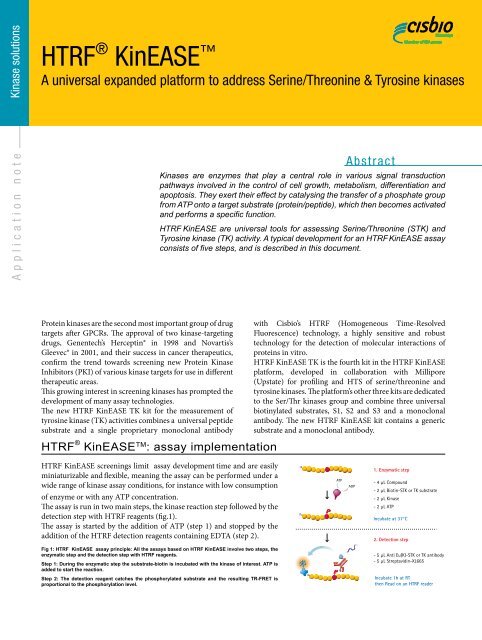
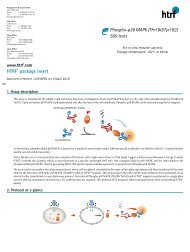

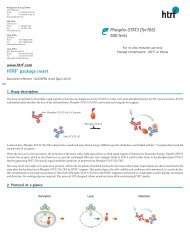
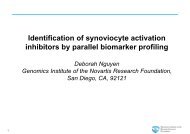
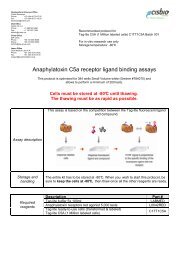
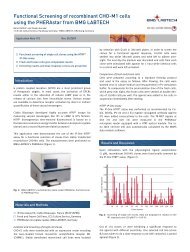
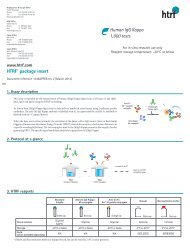
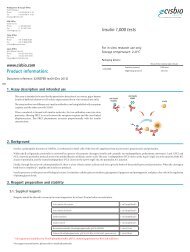
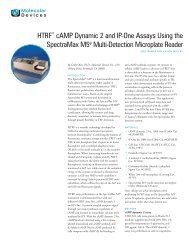

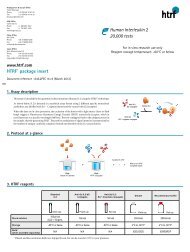
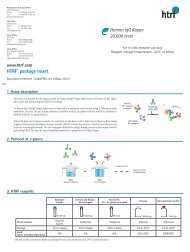
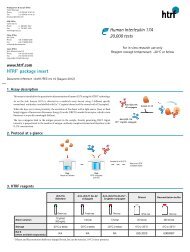

![HTRF meeting_130426_villa_pour pdf [Mode de compatibilité]](https://img.yumpu.com/22345646/1/190x135/htrf-meeting-130426-villa-pour-pdf-mode-de-compatibilitac.jpg?quality=85)